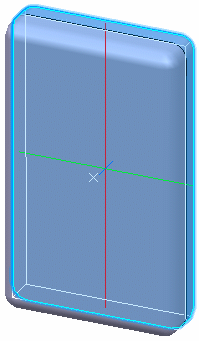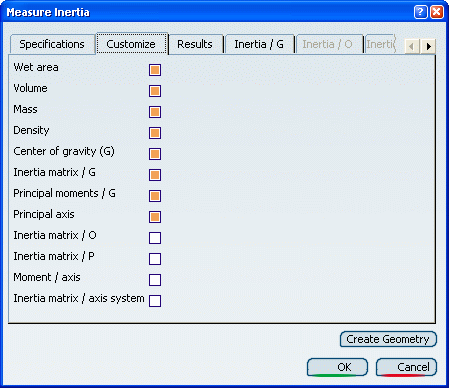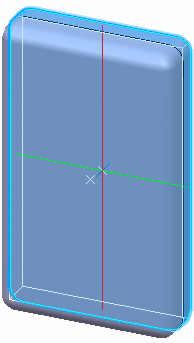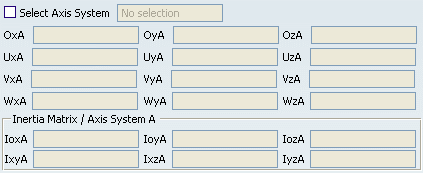Open the product or 3D shape representation on which
you wish to perform your inertia measuring operation.
To measure the inertia of a product, select Measure
Inertia
 in the Review Creation toolbar or in the Measure Tools toolbar.
in the Review Creation toolbar or in the Measure Tools toolbar.
Several things now happen:
-
The arrow pointer
 changes
to the measure inertia pointer
changes
to the measure inertia pointer
 on the representations of the geometry or specification
tree that can be selected for inertia measurement.
on the representations of the geometry or specification
tree that can be selected for inertia measurement.
-
The Measure Inertia dialog box
appears with the Specifications tab activated and all others grayed out. The Density field is automatically filled in (the value can be edited if it is the default density).
Note:
Inertia measurement is persistent in a 3D shape representation
context. It is linked with the geometry, but not with the material.
Using the measure inertia pointer
 , select a representation on which you wish to perform your inertia
measuring operation, either in the specification tree or in the geometry.
, select a representation on which you wish to perform your inertia
measuring operation, either in the specification tree or in the geometry.
The representation name is shown in the selection field
and the Customize, Results and Inertia/G
tabs are activated by default. The Create Geometry,
OK and Cancel buttons are also activated.
In the geometry of the selected representation, you
can now see:
-
the axis system
-
a bounding box parallel to the axes and bounding
the selected item
-
color-coded axes of inertia:
-
red: axis corresponding to the first moment
M1
-
green: axis corresponding to the second moment
M2
-
blue: axis corresponding to third moment M3

Click the Customize tab to define what to compute, and which tabs to display in the Measure Inertia
dialog box.

By default, the Inertia matrix / O,
Inertia matrix / P, Moment / axis and Inertia
/ Inertia matrix / axis system check boxes are not selected and
so the corresponding tabs i.e. Inertia / O, Inertia
/ P, the Inertia / Axis and Inertia / Axis System
are grayed out.
Click the Results tab.
This lets you see the results
of the operation: the area, the volume, the mass and the coordinates of the center of gravity.
Click Export tab.
The options in this tab lets you to specify the geometry to be created and the associativity required or not.
Note:
In VPM Digital Review product, Export tab is not available.
The next step depends on the product you are using. If you are in:
- VPM Digital Review: Click Create Geometry in the bottom right-hand corner of the Measure Inertia
dialog box.
- Part Design or Generative Shape Design: Click Create Geometry available in the Export tab.
This creates, from the inertia results, the center of gravity for the
principal axes in the geometry of the representation.

This also creates center of gravity
called Point.x in the specification tree:
Note:
- With Associativity option selected: When you create a point, three formulae are created. These three formulae will be displayed in the specification tree inside the relations set . These thee formulae will link the measure knowledge parameters and the parameters of the created points.
- With Associativity option cleared: No associativity will be there between the created
point and the inertia measure. The point cannot be updated to reflect
a change in the inertia computation result. If, for example, you move
the reference, the point will not be updated.
Click Measure.
The Measure Inertia dialog box closes.
![]()







